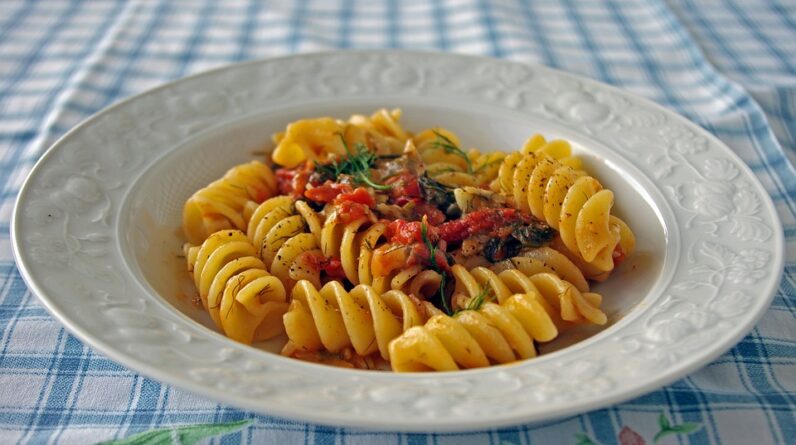If you’ve ever wanted to recreate the delicious flavors of authentic Italian cuisine in the comfort of your own kitchen, then look no further – we’ve got just the recipe for you! In this article, we will guide you through a detailed step-by-step process on how to make homemade Italian salsiccia, a mouthwatering sausage made from ground meat, typically pork, and seasoned with aromatic fennel seeds, garlic, and a blend of other tantalizing spices. Get ready to embark on a culinary adventure that will bring the taste of Italy right to your table.
How to Make Homemade Italian Salsiccia: A Detailed Recipe for Cooking Sausage with Ground Meat and Fennel Seeds
Are you looking to impress your family and friends with a delicious homemade Italian sausage? Look no further! In this article, we will guide you through a detailed recipe for making Italian salsiccia using ground meat and fennel seeds. With just a few simple ingredients and some basic techniques, you’ll be able to create flavorful sausages that will rival any store-bought variety. So, roll up your sleeves and get ready to embark on a culinary adventure!
Ingredients
To begin our sausage-making journey, let’s gather the necessary ingredients. Here’s what you’ll need:
- Ground meat (pork or a mix of pork and beef): The choice of meat will depend on your personal preference. Traditional Italian sausages often use a combination of pork and beef, which adds richness and flavor to the final product.
- Fennel seeds: Fennel seeds are a staple in Italian cuisine and provide a distinct taste to Italian sausages. We’ll be toasting and crushing these seeds to release their aromatic oils.
- Garlic cloves: Garlic adds a wonderful savory note to the sausages. Make sure to mince the garlic cloves finely to distribute the flavor evenly throughout the mixture.
- Salt: Salt is essential for enhancing the taste of the meat and balancing the flavors.
- Black pepper: Freshly ground black pepper adds a subtle kick to the sausages.
- Red pepper flakes: If you prefer a spicier sausage, red pepper flakes are a great addition. Adjust the quantity according to your taste.
- Paprika: Paprika gives the sausages a vibrant color and adds a mild smoky flavor.
- Cold water: Cold water will help bind all the ingredients together and keep the sausage mixture moist.
- Natural hog casings (optional): Hog casings are traditional for Italian sausages and give them their characteristic shape. If you prefer, you can also leave the sausages as bulk sausage without casings.
Preparation
Before we start stuffing our sausages, there are a few preparation steps we need to complete. Let’s get started!
- Toast the fennel seeds: In a dry skillet over medium heat, toast the fennel seeds until fragrant. This process will awaken their natural oils and intensify their flavor. Be careful not to burn them!
- Crush the fennel seeds: Once the fennel seeds have cooled, crush them using a mortar and pestle or a spice grinder. Crushing the seeds will release their flavor, infusing the sausages with a delightful taste.
- Mince the garlic cloves: Finely mince the garlic cloves to ensure they distribute evenly throughout the sausage mixture, enhancing its flavor profile.
- Combine the ingredients: In a large bowl, combine the ground meat, crushed fennel seeds, minced garlic, salt, black pepper, red pepper flakes, and paprika. Make sure to mix everything thoroughly, ensuring an even distribution of flavors.
- Gradually add cold water: Gradually add cold water to the mixture, mixing it in thoroughly after each addition. The water will help bind the ingredients together, giving the sausages a moist and succulent texture. Continue adding water until the mixture becomes sticky.
- Soak the hog casings (optional): If you’re using hog casings, soak them in water to remove excess salt and prepare them for stuffing. This step ensures that the casings are pliable and easy to work with during the stuffing process.

Stuffing the Sausage
Now comes the fun part – stuffing the sausages! Whether you choose to use hog casings or prefer your sausages in bulk, we’ll guide you through the process.
- Choose the casings or leave as bulk sausage: Decide whether you want to use hog casings for that classic sausage appearance or leave the sausages as bulk sausage. Both options are equally delicious!
- Prepare the sausage stuffer and casing attachment: If you’re using hog casings, ensure that your sausage stuffer and casing attachment are clean and ready for use. This will make the stuffing process much easier.
- Slide the soaked casing onto the sausage stuffer attachment: If you’ve opted for sausage casings, slide the soaked casings onto the sausage stuffer attachment, making sure to leave a little bit hanging over the end for tying.
- Tie a knot at the end of the casing: Tie a knot at the end of the casing to prevent the sausage mixture from leaking out during the stuffing process.
- Start feeding the sausage mixture into the casings: Slowly start feeding the sausage mixture into the casings using the sausage stuffer attachment. Be mindful not to overstuff the casings to allow room for twisting into individual links.
- Fill the casings tightly: Fill the casings firmly but not overly stuffed, ensuring a good distribution of the sausage mixture within the casings.
- Twist the sausages into individual links: Once you’ve stuffed the sausages, twist them at regular intervals to create individual links. This step ensures that the sausages are easy to cook and serve.
Cooking the Sausage
Congratulations, your sausages are now ready for cooking! Let’s explore some techniques to cook them to perfection.
- Heat a skillet over medium heat: To cook the sausages immediately, heat a skillet over medium heat. This will allow for even cooking and browning.
- Add a small amount of oil to the skillet: Add a small amount of oil to the skillet to prevent sticking and enhance the flavor. Olive oil or vegetable oil works well for this purpose.
- Cook until browned on all sides: Place the sausages in the skillet and cook, turning occasionally, until they are browned on all sides. Cooking time will depend on the thickness of the sausages.
- Ensure the internal temperature reaches 160°F (71°C): To ensure that your sausages are cooked through, use a meat thermometer to check the internal temperature. The sausages should reach a minimum internal temperature of 160°F (71°C).
- Freeze the uncooked sausage for later: If you want to save some sausages for later, freeze the uncooked sausages in airtight containers or freezer bags. They will stay fresh for up to three months.

Serving Suggestions
Now that your sausages are perfectly cooked, it’s time to enjoy them! Here are a few serving suggestions to inspire you:
- Grill the sausages for a smoky flavor: Fire up the grill and grill the sausages to add a delightful smoky flavor.
- Serve with crusty Italian bread: Slice the sausages and serve them with crusty Italian bread for a satisfying meal.
- Add to pasta dishes or pizza: Incorporate the sausages into your favorite pasta dishes or use them as a topping for homemade pizza for an extra burst of flavor.
- Create a sausage and peppers sandwich: If you’re in the mood for a hearty sandwich, slice the sausages and sauté them with some bell peppers and onions. Serve the mixture on a soft roll for a delicious sandwich.
- Use in various Italian recipes like lasagna or risotto: Get creative and use the sausages as an ingredient in classic Italian dishes such as lasagna or risotto. The flavors of the sausages will enhance the overall taste of these dishes.
Tips and Variations
To truly make the recipe your own, feel free to experiment with the following tips and variations:
- Add other spices or herbs: For a unique flavor profile, add additional spices or herbs such as rosemary, thyme, or oregano. These will further enhance the taste of your sausages.
- Try different ratios of ground meat: Play around with the ratio of ground meat to find the perfect combination for your taste. Combining 80% pork with 20% beef is a common blend, but you can adjust it to suit your preferences.
- Adjust the amount of fennel seeds and red pepper flakes: Tailor the amount of fennel seeds and red pepper flakes to your liking. If you like a stronger fennel or spicier flavor, feel free to increase the quantities.
- Try different types of ground meat: If you prefer a lighter or leaner option, consider using ground chicken, turkey, or even vegetarian alternatives instead of pork or beef. This will give your sausages a unique twist while catering to different dietary preferences.
Now that you have a comprehensive recipe for making homemade Italian salsiccia, it’s time to roll up your sleeves and start creating your own delicious sausages. With some practice and a touch of creativity, you’ll soon be serving up homemade Italian sausages that are sure to impress!









